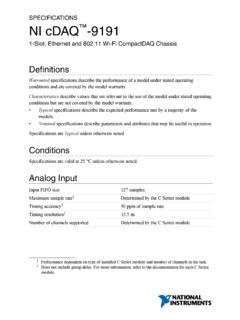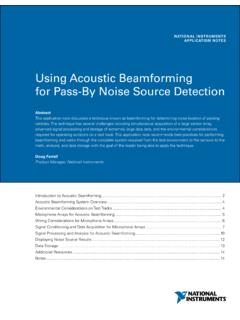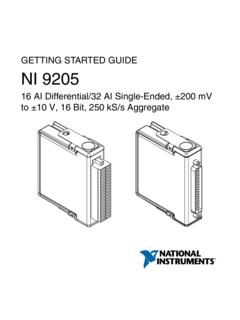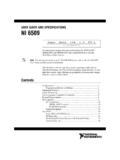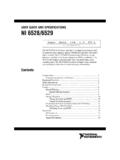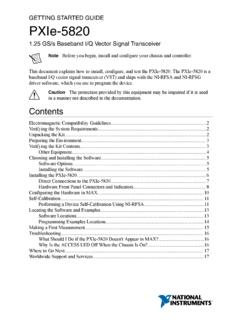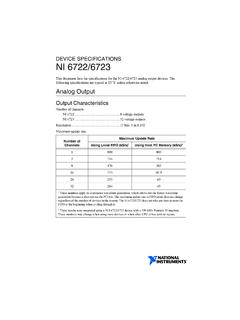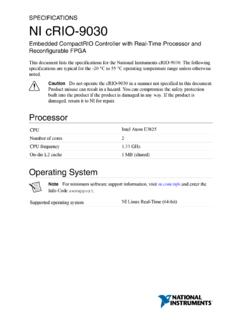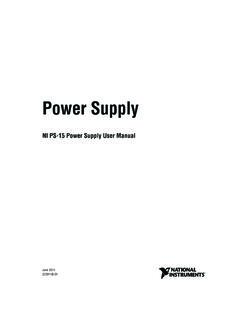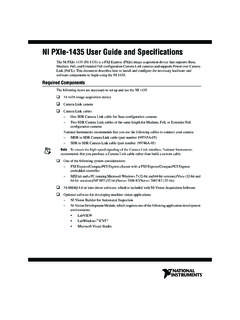Transcription of NI 9202 Datasheet - National Instruments
1 Datasheet . NI 9202. 16 AI, 10 V, 24 bit, 10 kS/s/ch Simultaneous DSUB or push-in spring terminal connectivity 250 V RMS, CAT II, channel -to-earth isolation (spring terminal); 60 V DC, CAT I, channel -to-earth isolation (DSUB). -40 C to 70 C operating, 5 g vibration, 50 g shock Note In this document, the NI 9202 with spring terminal and the NI 9202 with DSUB are referred to inclusively as the NI 9202. The NI 9202 is an analog input module for CompactDAQ and CompactRIO systems. Each channel provides a 10 V measurement range at a 24-bit resolution. The NI 9202 has a maximum sample rate of 10 kS/s and features programmable hardware filters.
2 By choosing one of the 5 different filter responses, a trade-off of fast settling time for increased noise rejection can be attained. NI 9202. Kit Contents NI 9202 Getting Started Guide NI 9940 Backshell Connector Kit (Spring Terminal). Accessories NI 9923 Screw-Terminal Block (DSUB). NI C Series Overview NI provides more than 100 C Series modules for measurement, control, and communication applications. C Series modules can connect to any sensor or bus and allow for high-accuracy measurements that meet the demands of advanced data acquisition and control applications. Measurement-specific signal conditioning that connects to an array of sensors and signals Isolation options such as bank-to-bank, channel -to- channel , and channel -to-earth ground -40 C to 70 C temperature range to meet a variety of application and environmental needs Hot-swappable The majority of C Series modules are supported in both CompactRIO and CompactDAQ.
3 Platforms and you can move modules from one platform to the other with no modification. CompactRIO. CompactRIO combines an open-embedded architecture with small size, extreme ruggedness, and C Series modules in a platform powered by the NI LabVIEW. reconfigurable I/O (RIO) architecture. Each system contains an FPGA for custom timing, triggering, and processing with a wide array of available modular I/O to meet any embedded application requirement. CompactDAQ. CompactDAQ is a portable, rugged data acquisition platform that integrates connectivity, data acquisition, and signal conditioning into modular I/O for directly interfacing to any sensor or signal.
4 Using CompactDAQ with LabVIEW, you can easily customize how you acquire, analyze, visualize, and manage your measurement data. 2 | | NI 9202 Datasheet Software LabVIEW Professional Development System for Windows Use advanced software tools for large project development Generate code automatically using DAQ Assistant and Instrument I/O Assistant Use advanced measurement analysis and digital signal processing Take advantage of open connectivity with DLLs, ActiveX, and .NET. objects Build DLLs, executables, and MSI installers NI LabVIEW FPGA module Design FPGA applications for NI RIO hardware Program with the same graphical environment used for desktop and real-time applications Execute control algorithms with loop rates up to 300 MHz Implement custom timing and triggering logic, digital protocols, and DSP algorithms Incorporate existing HDL code and third-party IP including Xilinx IP.
5 Generator functions Purchase as part of the LabVIEW Embedded Control and Monitoring Suite NI LabVIEW Real-Time module Design deterministic real-time applications with LabVIEW. graphical programming Download to dedicated NI or third-party hardware for reliable execution and a wide selection of I/O. Take advantage of built-in PID control, signal processing, and analysis functions Automatically take advantage of multicore CPUs or set processor affinity manually Take advantage of real-time OS, development and debugging support, and board support Purchase individually or as part of a LabVIEW suite NI 9202 Datasheet | National Instruments | 3.
6 NI 9202 Circuitry +. AI0+ 24-Bit Isolated Overvoltage AI0 Protection ADC.. programmable Filter +. AI15+. Overvoltage 24-Bit Isolated AI15 Protection ADC.. programmable Filter COM. NI 9202. input signals on each channel are buffered, conditioned, and then sampled by an ADC. Each AI channel provides an independent signal path and ADC, enabling you to sample all channels simultaneously. Filtering The NI 9202 uses a combination of analog and digital filtering to provide an accurate representation of in-band signals while rejecting out-of-band signals. The filters discriminate between signals based on the frequency range, or bandwidth, of the signal.
7 The NI 9202 represents signals within the passband, as quantified primarily by passband flatness and phase linearity. The NI 9202 has a comb frequency response, characterized by deep, evenly spaced notches and an overall roll-off towards higher frequencies. The NI 9202 provides five available filter options for every data rate. The different options provide a trade-off of noise rejection (refer to Idle channel Noise table) for filter settling time (refer to Settling Time equation) and latency (refer to input Delay equation). To control the response of the programmable comb filter, you can select to have the first notch at 1, 1/2, 1/4, 1/8 or 1/16 of the sampling frequency.
8 The following figures show the overall filter response with different filter settings. 4 | | NI 9202 Datasheet Figure 1. Filter Response for Filter Decimation Rate 2. 0. 10. 20. 30. Gain (dB). 40. 50. 60 Notch at fS. Notch at fS/2. Notch at fS/4. 70 Notch at fS/8. Notch at fS/16. 80. 0 Frequency (Hz) / Data Rate (S/s). Figure 2. Filter Response for Filter Decimation Rate 4. 0. 10. 20. 30. Gain (dB). 40. 50. 60 Notch at fS. Notch at fS/2. Notch at fS/4. 70 Notch at fS/8. Notch at fS/16. 80. 0 Frequency (Hz) / Data Rate (S/s). NI 9202 Datasheet | National Instruments | 5. Figure 3. Filter Response for Filter Decimation Rate 5.
9 0. 10. 20. 30. Gain (dB). 40. 50. 60 Notch at fS. Notch at fS/2. Notch at fS/4. 70 Notch at fS/8. Notch at fS/16. 80. 0 Frequency (Hz) / Data Rate (S/s). Figure 4. Filter Response for Filter Decimation Rate 8. 0. 10. 20. 30. Gain (dB). 40. 50. 60 Notch at fS. Notch at fS/2. Notch at fS/4. 70 Notch at fS/8. Notch at fS/16. 80. 0 Frequency (Hz) / Data Rate (S/s). Note Refer to the Data Rates section for more information on the Filter Decimation Rate values. Passband The signals within the passband have frequency-dependent gain or attenuation. The small amount of variation in gain with respect to frequency is called the passband flatness.
10 The programmable comb filters of the NI 9202 adjust the frequency range of the passband to match the data rate and filter setting. Therefore, the amount of gain or attenuation at a given frequency depends on the data rate and filter setting. 6 | | NI 9202 Datasheet Figure 5. Typical Flatness for Filter Decimation Rate 2. 0. Notch at fS. Notch at fS/2. Notch at fS/4. Notch at fS/8. 3. Notch at fS/16. Gain (dB). 6. 9. 12. 0 Frequency (Hz) / Data Rate (S/s). Figure 6. Typical Flatness for Filter Decimation Rate 4. 0. 3. Gain (dB). 6. 9 Notch at fS. Notch at fS/2. Notch at fS/4. Notch at fS/8. Notch at fS/16.
